Lost Technologies of Ancient Egypt
Advanced Engineering in the
Temples of the Pharaohs
by Christopher
Dunn
The landscape of the ancient world
is dotted with fabulous structures that are breathtaking in their complexity. The Egyptians
and Mayans had their pyramids and temples. The Hindus crafted elaborate temples
throughout Asia. The Greeks built the Parthenon, and the Babylonians
constructed the Jupiter Temple and the fabled Hanging Gardens. The Romans made
their mark all over their world, with engineering geniuses guiding the
construction of their famous roads, the Coliseum, and numerous temples and
viaducts, while Roman sculptors guided their chisels over marble and alabaster,
giving it physical presence and beauty.

With the exception of artifacts such
as the mysterious Antikythera Mechanism, an astronomical computer found by
fishermen on the sea floor near the island of Antikythera in 1901, the
development of technology in the ancient world seems to have clear origins and
is fairly well understood.


Figure 1. Entrance to the Serapeum
Going back yet
further in time, a deeper mystery lies in the question of how the ancient
Egyptian civilization could have flourished for three thousand years without improving the tools used to
quarry and shape stone to near perfection. Since 1984, when Analog magazine published my article
“Advanced Machining in Ancient Egypt?” controversy on this subject has
persisted. The article proposed that the ancient Egyptians were more advanced
than previously believed and that they used advanced tools and methods to cut
granite, diorite, and other difficult-to-work stone. It does not seem credible
that brilliant architects and engineers would continue to use stone tools and
copper chisels for three millennia.
The most
stunning and convincing artifacts that clearly contradict theories about how
hard igneous rock was quarried and worked in prehistory are the incredible
granite and basalt boxes in the rock tunnels of the Serapeum at Saqqara. Within
these mysterious tunnels that were carved out of the limestone bedrock are over
20 huge granite boxes. These 70 ton boxes with their 20 ton lids were quarried
at Aswan over 500 miles away and installed in arched crypts recessed into the
walls of the labyrinth of underground tunnels. All of the boxes were finished
on the inside and the bottom side of the lid, but not all were finished on the
outside. It appears that work stopped suddenly in the Serapeum, for there were
boxes in several stages of completion: boxes with lids, boxes that had yet to
have the lids placed on them, and the rough box and lid near the entrance. The
floor of each crypt was several feet lower than the tunnel floor. Iron railings
were installed to prevent visitors from falling.
In 1995
I inspected the inside and outside surfaces of two boxes in the Serapeum with a
6-inch precision straight edge that was accurate to .0002 inch.
In one
of the crypts there is a granite box with a broken corner, and this box is
accessible by means of steps down to the lower floor. The outside of the box
appears to be roughly finished, but the glint of a high polish on the inside
surfaces beckoned me to climb inside. Running my hand along the surface of the
granite reminded me of the thousands of times I have run my hand along a
granite surface plate when I was working as a machinist and later as a tool and
die maker. The feel of the stone was no different, though I was not sure of its
flatness or accuracy.
To check
my impression, I placed the edge of my precision-ground parallel against the
surface—and I saw that it was dead flat. There was no light showing through the
interface of the steel and the stone, as there would be if the surface was
concave, and the steel did not rock back and forth, as it would if the surface
was convex. To put it mildly, I was astounded. I did not expect to find such
exactitude, because this order of precision is not necessary for the
sarcophagus of a bull—or any other animal or human.
I slid the parallel along the surface both horizontally
and vertically, and there was no deviation from a true, flat surface. The
flatness was similar to precision-ground surface plates that are used in
manufacturing for the verification of exactly machined parts for tools, gauges,
and myriad other products that require extremely accurate surfaces and
dimensions. Those familiar with such products and the relationship between
gauges and surface plates know that the gauge may show that the stone is flat
within the tolerance of the gauge—in this case 0.0002 inch (0.00508 millimeter)
flatness. If the gauge is moved 6 inches along the stone surface, however, and
the same conditions are found, it cannot be claimed with certainty that the
stone is within the same tolerance over 12 inches—unless the plate has been
inspected by another means and is calibrated to a known standard.
Nonetheless,
moving the steel edge along the granite provided enough information for me to
conclude that I needed a longer straight edge—and, preferably, even more
sophisticated alignment equipment—to determine the accuracy of the inside
surfaces of the box. I was also impressed to find that each corner of the box
had a small radius that ran from the top of the box to the bottom, where it
blended with the corner radius of the floor of the box.
The
artifacts I have measured in Egypt have the marks of careful and remarkable
manufacturing methods. They are unmistakable and irrefutable in their precision
but origin or intent will always be open to speculation. The following series
of photographs were taken inside the Serapeum on August 27, 2001. Those taken
of me inside one of these huge boxes show me inspecting the squareness between
a 27 ton lid and the inside surface of the granite box on which it sits. The
precision square I used was calibrated to .00005 inch (that is 5/100,000 of an
inch) using a Jones & Lamson comparitor.
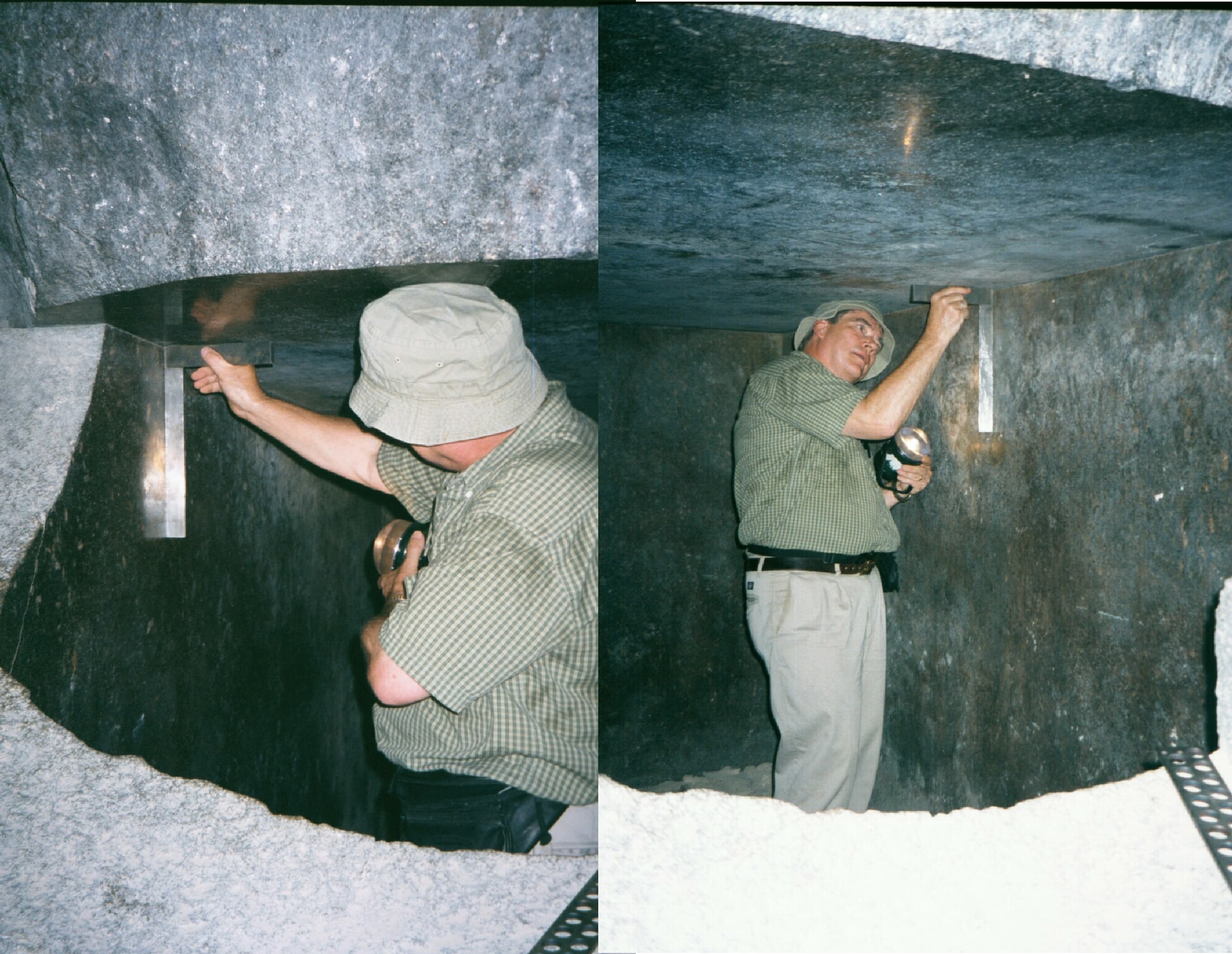
Figure 2. Inspecting the inside of
the granite boxes
The underside of the lid and the
inside wall of the box I found to be square, and finding that the squareness
was achieved not just on one side of the box but both, raises the level of difficulty
in accomplishing this feat.
Think of
it as a geometric reality. In order for the lid to be square with the two
inside walls, the inside walls would have to be parallel to one another along
the vertical axis. Moreover, the topside of the box would need to establish a
plane that is square to the sides. That makes finishing the inside
exponentially more difficult. The manufacturers of these boxes in the Serapeum
not only created inside surfaces that were flat when measured vertically and
horizontally, they also made sure that the surfaces they were creating were
square and parallel to each other, with one surface, the top, having sides that
are 5 feet and 10 feet apart from each other. But without such parallelism and
squareness of the top surface, the squareness noted on both sides would not
exist
The flat
surfaces of the inside of the boxes exhibited a high degree of accuracy that is
comparable to surfaces found on surface plates in modern manufacturing
facilities.
Finding
such precision from any epoch in human history leads one to conclude that a
sophisticated system of precise measure must have been in existence. This is an
area of intense interest to engineers—such as myself—who find in Egypt a
language with which we are familiar. This is the language of science,
engineering, and manufacturing. Our counterparts in that ancient land left
future generations of scientists, engineers, architects, and those who take
their instructions and shape materials to their specifications, with a
difficult challenge. This challenge is to recognize what they created and
provide evidence-based, reasonable answers that give the ancient engineers
credit for what they achieved.
The ancient Egyptians who built the pyramids
and temples, who crafted monumental statues out of igneous rock, were thinking
with the minds of architects, engineers, and craftspeople. Were ancient
archaeologists responsible for the legacy they left us? Without the advice of
modern Egyptian architects, engineers, and craftspeople, are today’s Egyptian
archaeologists missing something? Are modern interpretations of the awesome
feats of the ancient Egyptians irrelevant in providing new and powerful
information about this ancient culture? Are the thoughts and conclusions of
Western writers and travelers who stood in front of the Great Pyramid one
hundred years ago (or some forty-five hundred years after it was built) more
intrinsically linked to the ancient Egyptian mind than those who come after
them, a century or more later? What can be described as a “modern perspective?”
In his time, Herodotus would surely have been considered modern. So were
Egyptophiles Petrie, Marriette, Champollion, and Howard Carter—each in
possession of a modern mind that was clothed in a fabric of prejudices and
stereotypes that existed within their own culture.
When it
comes to completely understanding the ancient Egyptians’ level of technological
prowess, there can be no final conclusion. What is left to study today is a
mere skeleton of what existed at the time of the ancient Egyptians. This
skeleton survives as highly sophisticated and precisely crafted sedimentary and
igneous rock. It is my belief that the clothes we have placed on this skeleton
are mere rags compared to what should be there. I have proposed in the past that
higher levels of technology were used by the ancient Egyptians, but for the
sake of argument, I have rejected some ideas and cast doubt on my previous
assertions as to the level of technology they enjoyed. At the same time, I cast
doubt on the methods of manufacture that Egyptologists have asserted were used
to build the pyramids and the glorious temples in Egypt. These methods are
primitive and include stone and wooden mallets; copper chisels; tube drills and
saws; and stone hammers for quarrying, dressing, and sculpting hard igneous
rock.
Having
knowledge of the incredible precision in the boxes in the Serapeum, we should
be reminded of the work of Sir William Flinders Petrie, who measured and
recorded for prosperity the marvelous layout of the Giza Plateau, and
particularly the accuracy and true alignment of many of the features found in
the Great Pyramid. His measurements discovered that the casing stone were cut
within .010 inch and the constructed portion of the Descending Passage was
accurate to within the thickness of a thumbnail (.020 inch) over a length of
150 feet.
To
understand how the ancient Egyptians created these testaments to manufacturing
prowess, we need to rely on an examination by scientists and engineers. They
would take measurements with modern tools and analyze the full scope of the
work and compare them with our own capabilities. The full scope of the work
includes the most difficult aspects of the work, which are ignored by
Egyptologists when they attempt to explain how the ancient Egyptians created
their monuments. For instance, dragging a 25 ton block of granite over wooden
rollers, with great difficulty, does not explain how a 500 ton obelisk or
monolithic statues weighing 1000 tons were moved by prehistoric people. Bashing
out a few cubic centimeters of granite with a dolerite ball does not explain
how thousands of tons of granite were extracted from the bedrock and shaped
with extreme precision and displayed as monumental pieces of art in the temples
of Upper Egypt. To know the true majesty and capability of the ancient
Egyptians, one only has to know and appreciate the full extent of their work.
While
the boxes in the Serapeum present a significant challenge to those who attempt
to explain ancient Egyptian craftsmanship, they are not complex surfaces, like
the surfaces that combine to create the magnificent statues of Ramses II that
grace the Temples of the South and the North. But why, you might ask, would I
turn my attention away from engineering precision to a sculpture? Because the
monolithic statues of Ramses issue a challenge to all who would care to explain
how they were made.
What am
I?
How did
I come to exist?
Make
another just like me!
What
does the face of Ramses have in common with a modern precision engineering
object, such as an automobile? It has flowing contours with distinct features
that are perfectly mirrored one side to the other. The fact that one side of
Ramses face is a perfect mirror image to the other implies that precise
measurements had to have been used in its creation. It means that the statue
was carved in intricate detail to create precise three-dimensional surfaces.
The
jaw-lines, eyes, nose and mouth are symmetrical and were created using a
geometric scheme that embodies the Pythagorean Triangle as well as the Golden
Rectangle and Golden Triangle. Encoded in the granite is the sacred geometry of
the ancients.
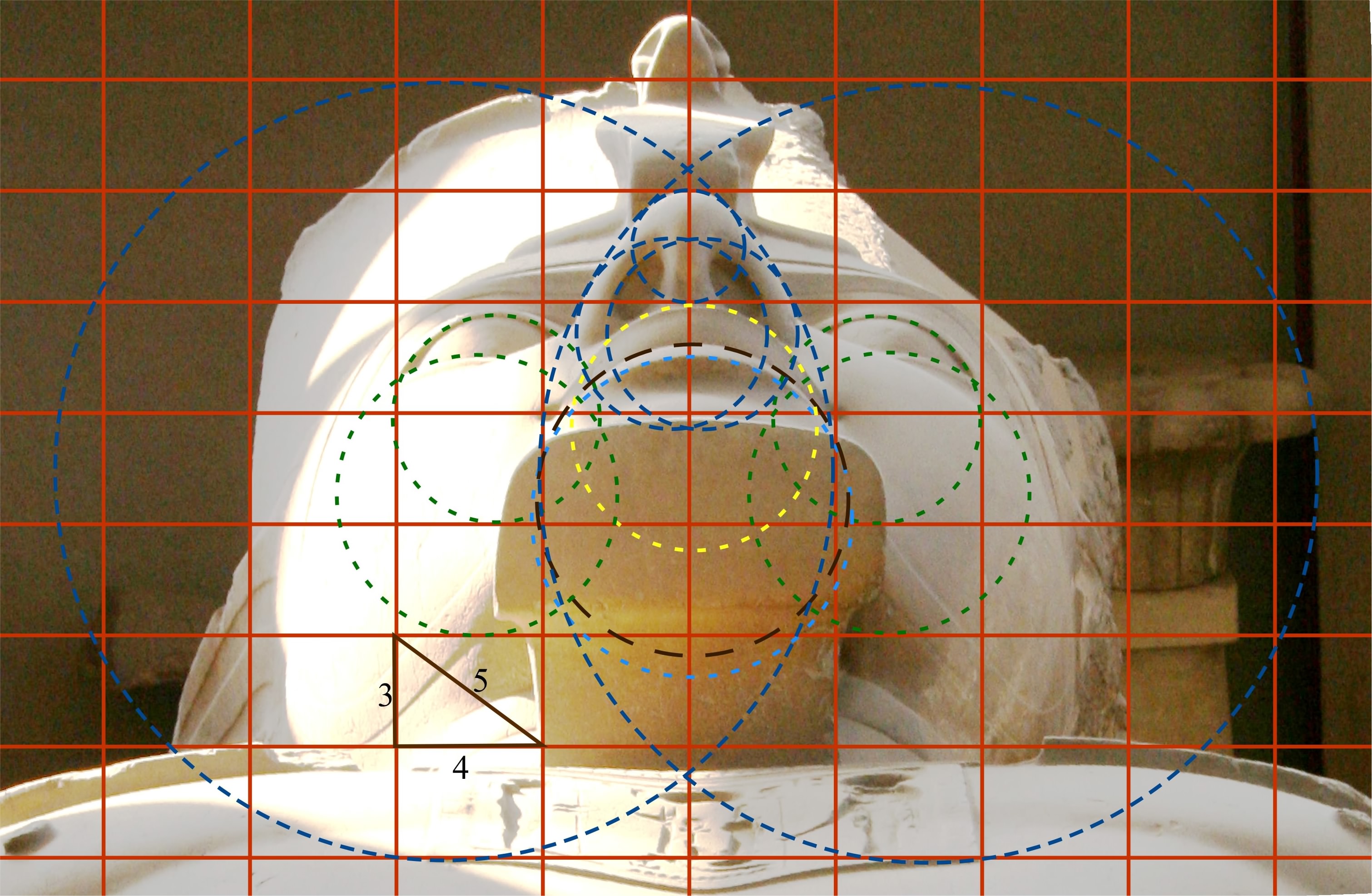
Figure 3. The Statue of Ramses at
Memphis
When I
was researching for my book, The Giza
Power Plant, I had my first encounter with Ramses the Great. This was at
the open air museum at Memphis. It was in 1986 and my interest was mostly
engineering and the pyramids, so I was not necessarily interested in statues or
visiting the temples in the south. It struck me as peculiar at the time,
though, that while looking down the length of the 300 ton Ramses statue I
noticed that the nostrils were identically shaped and symmetrical. The
significance of this feature gained more prominence when I eventually visited
the temples in 2004 and became fascinated with the three-dimensional perfection
of the Ramses statues at Luxor. This fascination prompted me to gather digital
images so that I could examine some of the features of Ramses in the computer.
What I discovered was remarkable in that the images revealed a much higher
level of manufacturing technology than what has been discussed previously.
In
gathering the images of Ramses, it was important that the camera was oriented
along the central axis of the head. This way the distribution of material on
the left and right side was equal. In order to compare one side of the face to
the other, a copy of the image was made, flipped horizontally and made 50%
transparent. Then the reverse image was positioned over the original to compare
the two sides.
The
results are remarkable. The stunning implications are analogous to looking
through the static interference pattern of time and confusion and seeing the
elegance and precision that is normally built into a Lexus in a place where
only the most rudimentary techniques of manufacturing are thought to have
existed. The techniques that the ancient Egyptians are supposed to have
used—those taught us in school—would not produce the precision of a Model T
Ford, let alone a Lexus or a Porsche.
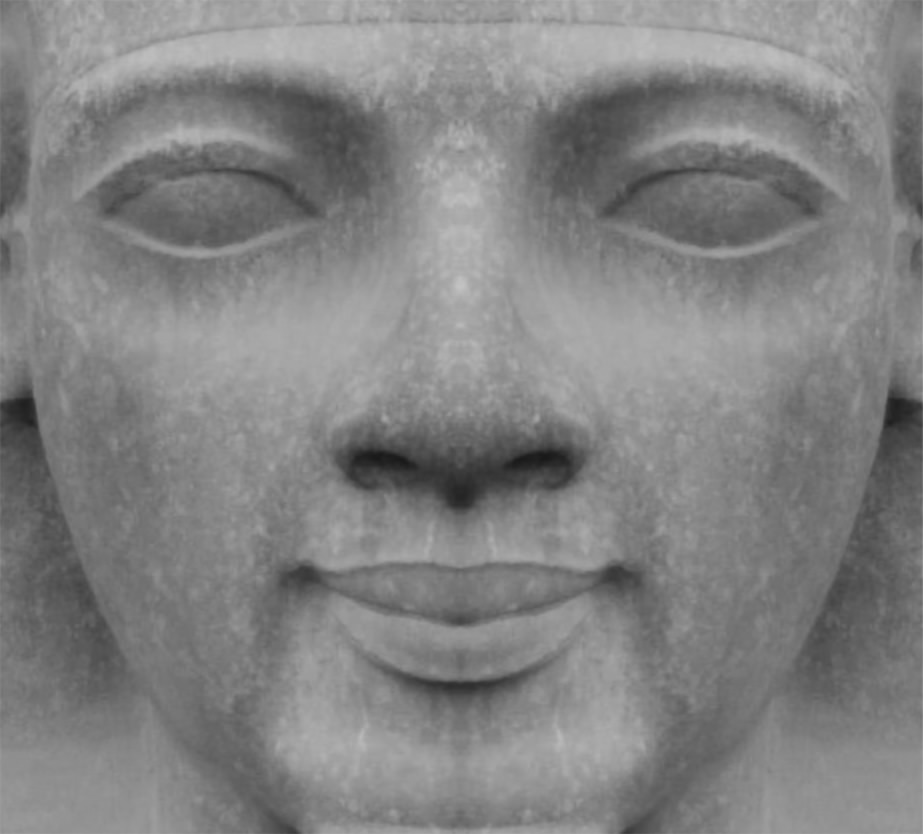
Figure 4. The Symmetry of Ramses
at Luxor
We know
that the ancient Egyptians used a grid in their designs, and that such a method
or technique for design is intuitively self-evident. It does not require a
quantum leap of an artisan’s imagination to arrive at what is today a common
design method. In fact, it is used now not just for design, but also for
describing organizational and conceptual methodology. Grids, graphs, and charts
are used to convey information and to plot and organize work.
With
this in mind, therefore, I took the photograph of Ramses and laid a grid over
it. Of course, my first task was to establish the size and number of the cells
used in the grid. I assumed that the features of the face would lead me to the
answer, and studied which features were most prominent. After musing over this
puzzle for a while, I took a chance on a grid that was based on the dimensions
of the mouth. It seemed to me that the mouth had something to tell us due to
its unnaturally upturned shape, so I placed a grid with cell dimensions that
were the same height and half the width of the dimensions of the mouth. It was
then a simple matter to generate circles based on the geometry of the facial features.
I didn’t expect, though, that they would line up with grid lines in so many
locations. In fact, I was astounded by this discovery. Going through my mind
was: “Okay—now when does this cease to be a coincidence and become a reflection
of truth?”
Plumbing
the grid for further information, I discovered that Ramses’ mouth had the same
proportions as a classic 3-4-5 right triangle. The idea that the ancient
Egyptians had known about the Pythagorean triangle before Pythagoras, and they
may have even taught Pythagoras its concepts, has been discussed by scholars,
though not without controversy. Ramses presented me with a grid based on the
Pythagorean triangle, whether it was the ancient Egyptians’ intentions or not.
As we can see in figure 5, the Pythagorean grid allows us to analyze the face
as it has never been analyzed before.
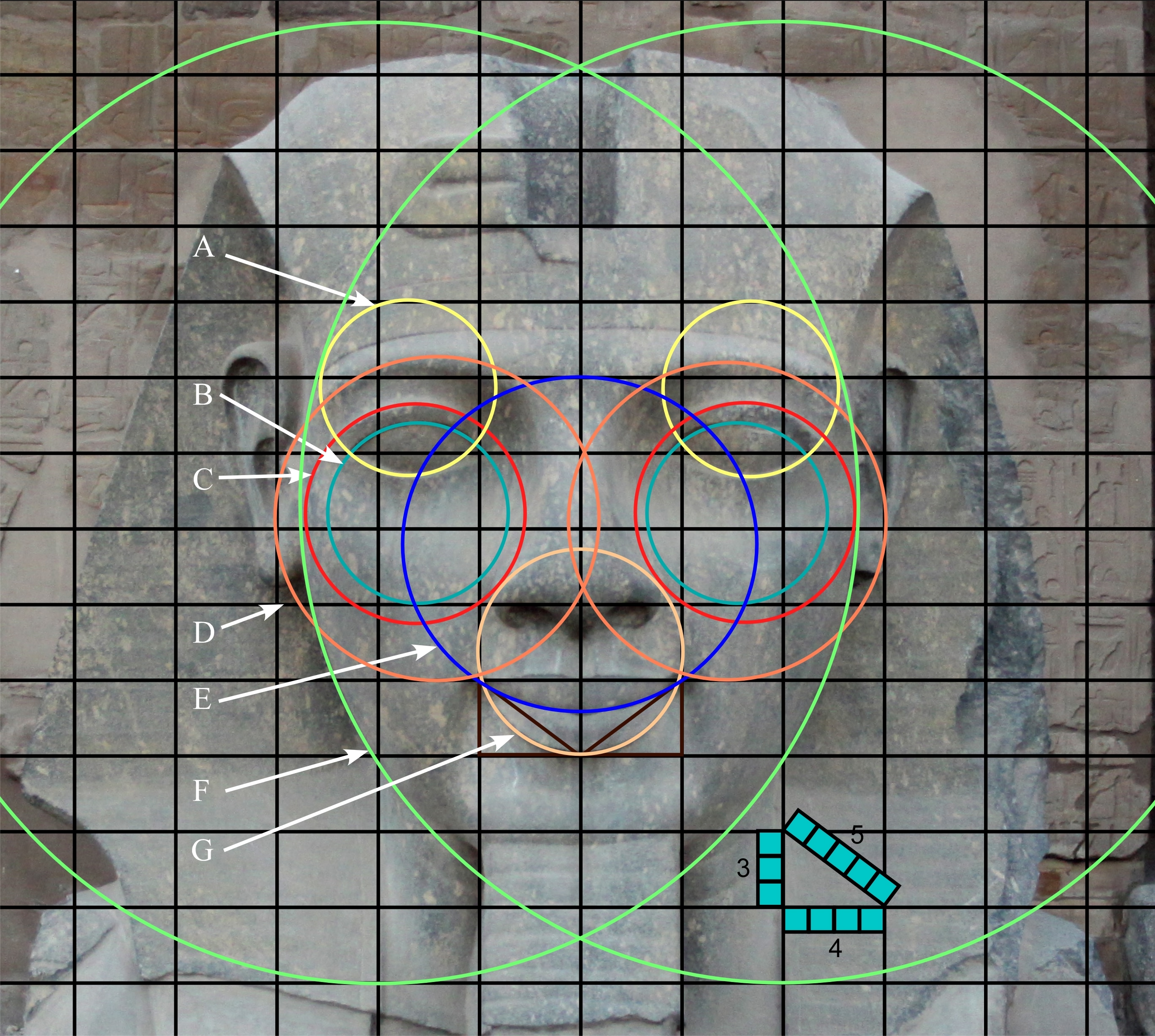
Figure 5. The Geometry of Ramses
at Luxor]
The
Ramses geometry and precision and the discovery of tool marks on some of the
statues are discussed at greater length in Lost
Technologies of Ancient Egypt. Small
seemingly insignificant mistakes made by ancient tools bring to light
information from which a precise controlled method of manufacture can be
discerned.
Other
remarkable features of machining on granite are also examined, but probably the
most stunning example of ancient machining lies on a wind-swept hill 5 miles
from the Giza Plateau. Abu Roash has recently been advertised as the “Lost
Pyramid” by Zahi Hawass, the secretary general of the Egyptian Supreme Council
of Antiquities, even though it has been well known and written about for many
years. I wasn’t expecting much when I first visited the site in February 2006,
but what I found was a piece of granite so remarkable that I returned to that
site 3 more times to show witnesses in order to explain its unique features.
Those who accompanied me on different occasions were David Childress, Judd
Peck, Edward Malkowski, Dr. Arlan Andrews and Dr. Randall Ashton. Edward
Malkowski immediately dubbed the stone the new rose-red Rosetta Stone.
Mechanical engineer Arlan Andrews independently came to the same conclusion.
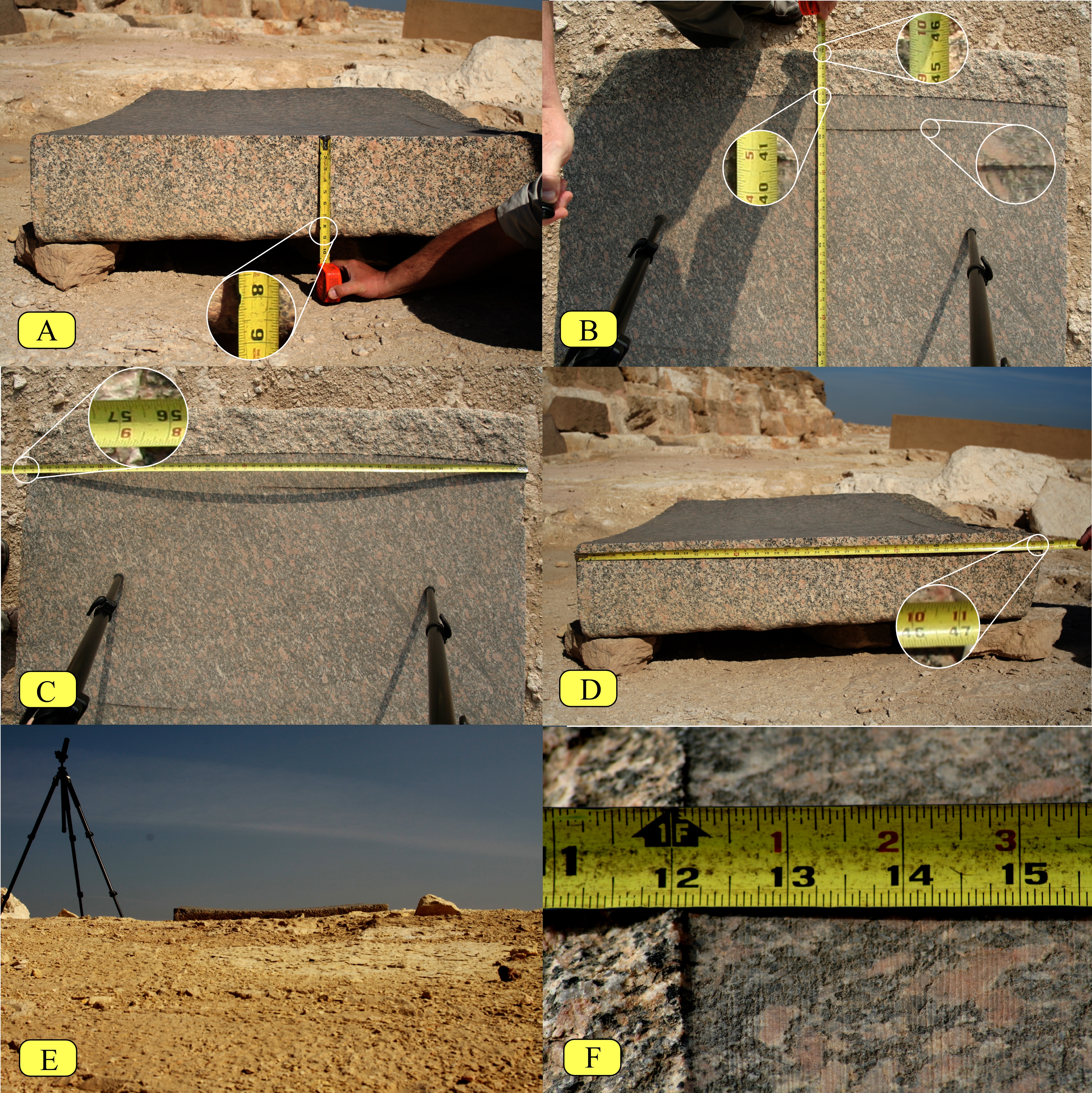
Figure 6. Views of the stone at
Abu Roash
Looking closer at the surface of
the block in figure 6 - F, we can see striations that are spaced between
approximately 0.030 inch (0.762 millimeter) to 0.06 inch (1.52 millimeters)
apart. These are a common feature on many artifacts found in Egypt, including
some holes and the cores that were extracted from the holes. The radius where
the cut surface terminates is puzzling when we consider different ways in which
the block may have been made.
One suggestion made to me was that
the blade that cut the piece was a straight saw but that it was warped and cut
the curve on the stone face. If that were possible, it would explain one radius
on the block, but whether you view the block from above, or along its length,
you see a radius. When considering this and pondering on how this inexplicable
geometry was cut into the granite, the straight saw has to be eliminated,
because it would be impossible for it to cut a concave radius along its face
and along its edge. Another suggestion given to me was that the stone was cut
by a stone ball swinging from a pivot point. Yet the evidence suggests a far
greater amount of control and certainty than that of a swinging ball—regardless
of the skill put into the swing.
I tried
to imagine a process in which the piece would be cut in one single sawing
operation, but I could not come up with a method that did not demand more out
of the tool than was possible due to an increase in surface area being cut. In
other words, assuming a larger block was being cut along the striated surface
with the saw on an angle, depending on the thickness of the entire block, the
thin block, which is the one we are studying, would break apart from the
thicker one. But passing the stone across the saw on an angle would result in
an increase in the surface area being cut. In pursuing an answer to the puzzle,
while providing an answer to Petrie’s question about the size of the saw, it
was necessary to calculate the radius of the saw—the granite block at Abu
Roash, provided the attributes to calculate that the stone was cut with a
circular saw that was over 37 feet in diameter. This seems almost impossible to
believe, but the evidence is cut into the stone for anyone to measure and
illustrated in figure 7 and 8 for verification.
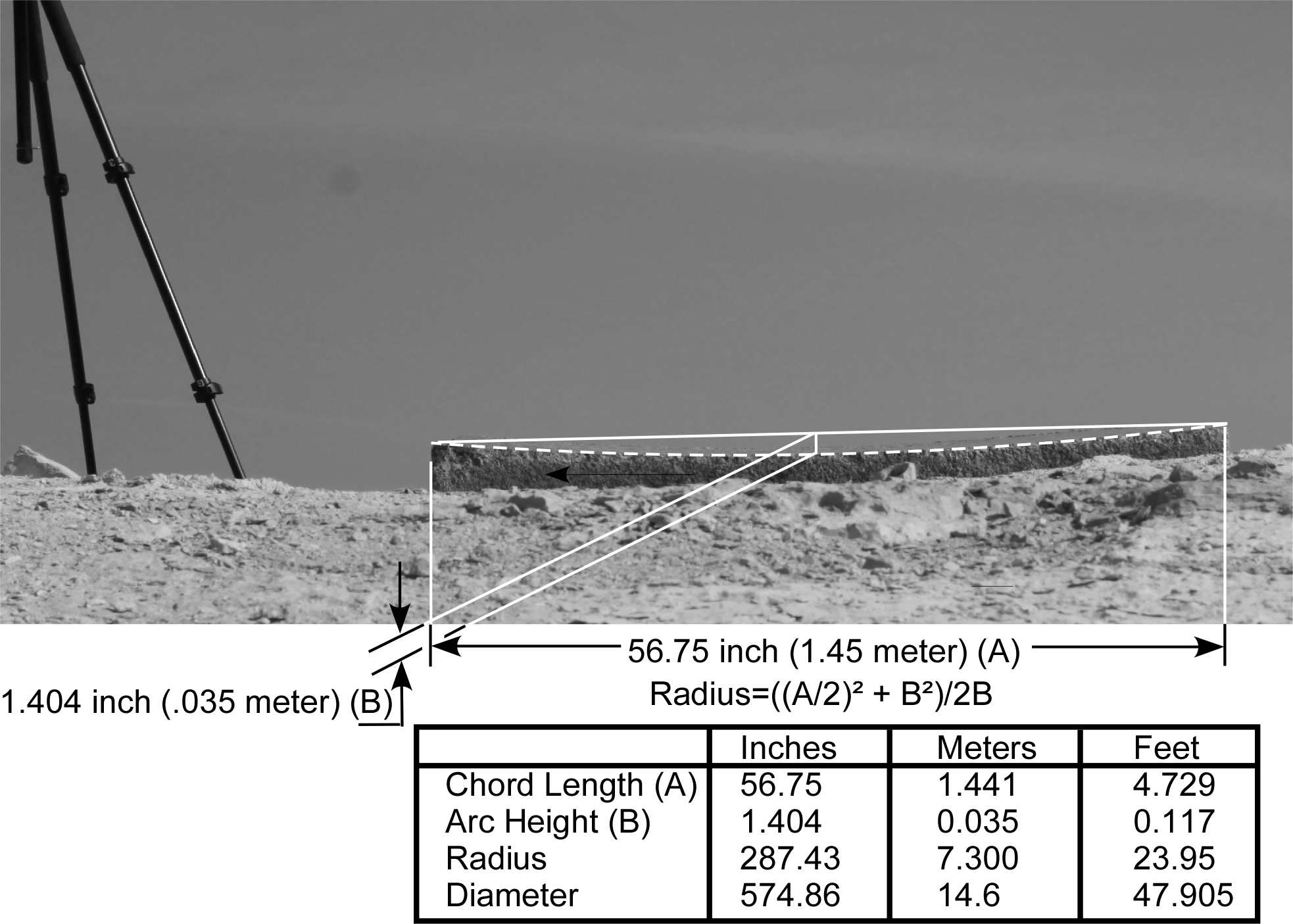
Figure 7. Axial view of Abu Roash
Stone
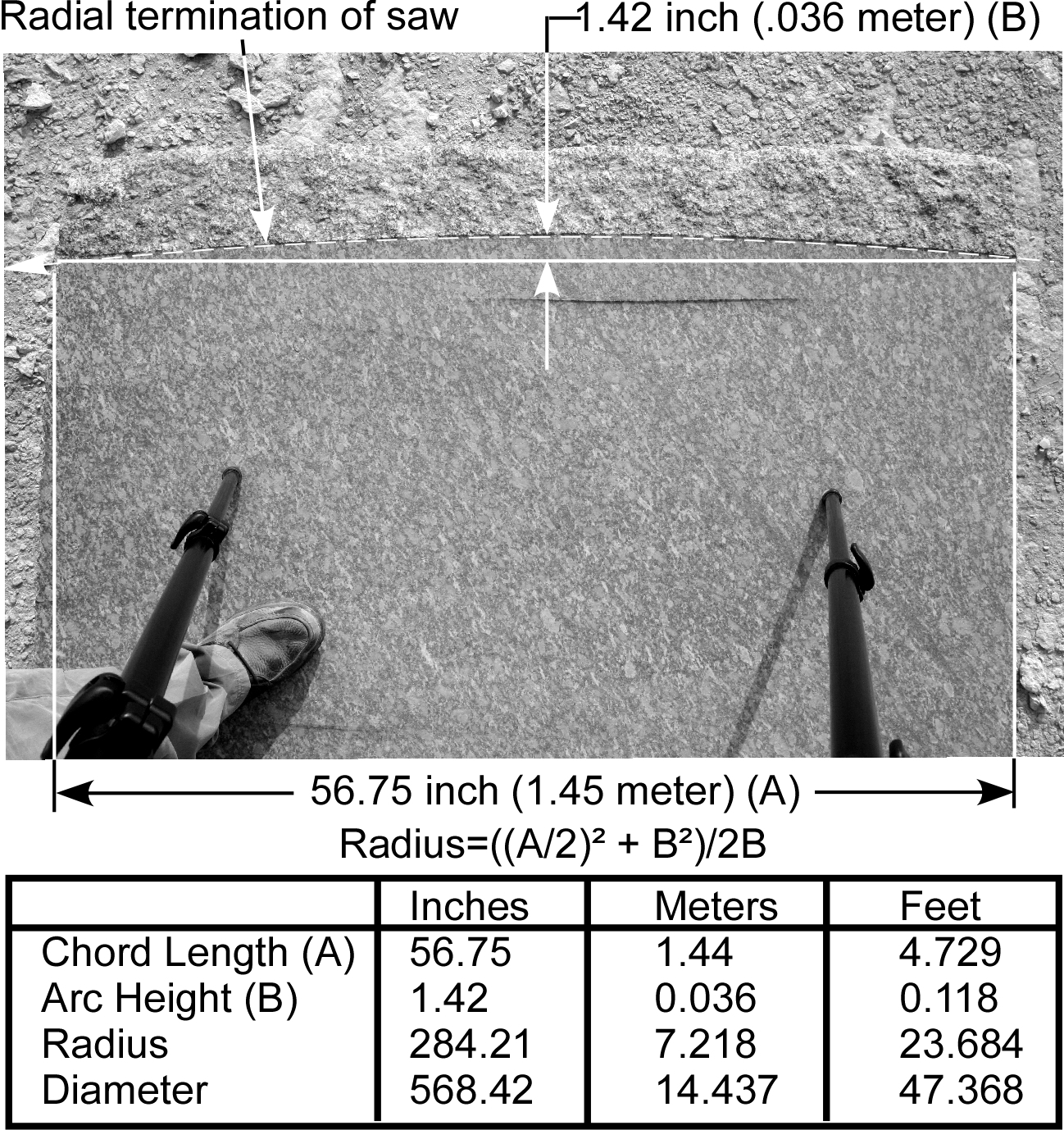
Figure 8. Top view of Abu Roash
Stone
The
boxes in the Serapeum, the Ramses Statue and the stone at Abu Roash, are three
examples of many that have been closely examined and are discussed in Lost Technologies of Ancient Egypt.
Other unique artifacts, include the Hypostyle Hall in the Temple of Denderah,
the contoured blocks on the Giza Plateau, the Unfinished Obelisk and the
infamous Petrie’s core #7, a unique artifact that has been a source of
controversy since Petrie first discovered it. And the White crown of Upper
Egypt – a remarkable example of ancient Egyptian geometry and manufacturing.
Ellipsoids and ellipses were part and parcel of the ancient Egyptian knowledge.
The stunning evidence is precisely crafted into hard granite and speaks louder
than any tomb drawing about the amazing capabilities of the ancients.
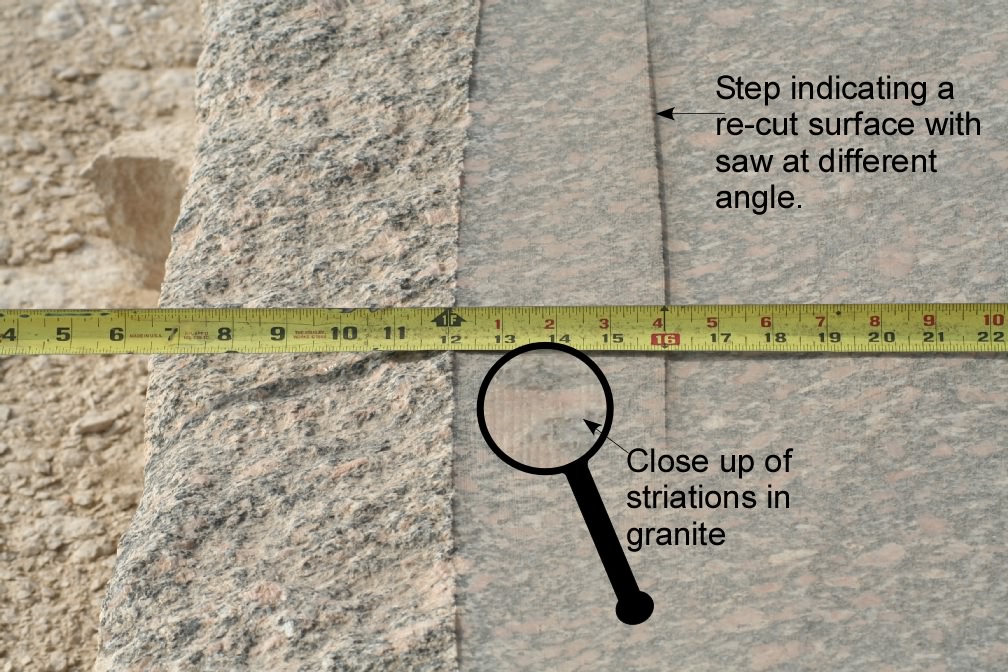
From Giza Power @ http://www.gizapower.com/LoTeAnArticle.htm
For more information about the Great Pyramid see http://nexusilluminati.blogspot.com/search/label/great%20pyramid
For more information about hidden history see http://nexusilluminati.blogspot.com/search/label/hidden%20history
- See ‘Older Posts’ at the end of each section
YOU can help this unique
independent website stay online from a small cabin in a remote rainforest
Donate any amount and receive at least one New Illuminati eBook!
Please click in the
jar -
For further enlightening
information enter a word or phrase into the random synchronistic search box @ http://nexusilluminati.blogspot.com
And see
New Illuminati – http://nexusilluminati.blogspot.com
New Illuminati on Facebook - https://www.facebook.com/the.new.illuminati
New Illuminati Youtube Channel - http://www.youtube.com/user/newilluminati/feed
The Her(m)etic Hermit - http://hermetic.blog.com
The Prince of Centraxis - http://centraxis.blogspot.com (Be Aware! This link leads to implicate &
xplicit concepts & images!)
DISGRUNTLED SITE ADMINS PLEASE NOTE –
We provide a live link to your original material on your site - which
raises your ranking on search engines and helps spread your info further! This site
is published under Creative Commons Fair Use Copyright (unless an individual article
or other item is declared otherwise by copyright holder) – reproduction for non-profit
use is permitted & encouraged, if you give attribution to the work &
author - and please include a (preferably active) link to the original (along
with this or a similar notice).
Feel free
to make non-commercial hard (printed) or software copies or mirror sites - you
never know how long something will stay glued to the web – but remember
attribution! If you like what you see, please send a donation (no amount is too
small or too large) or leave a comment – and thanks for reading this far…
Live long
and prosper!
From the New
Illuminati – http://nexusilluminati.blogspot.com
Once set-up, the plates do not require extensive care and maintenance. But, it is important to follow some basic rules while using surface plates.
ReplyDelete